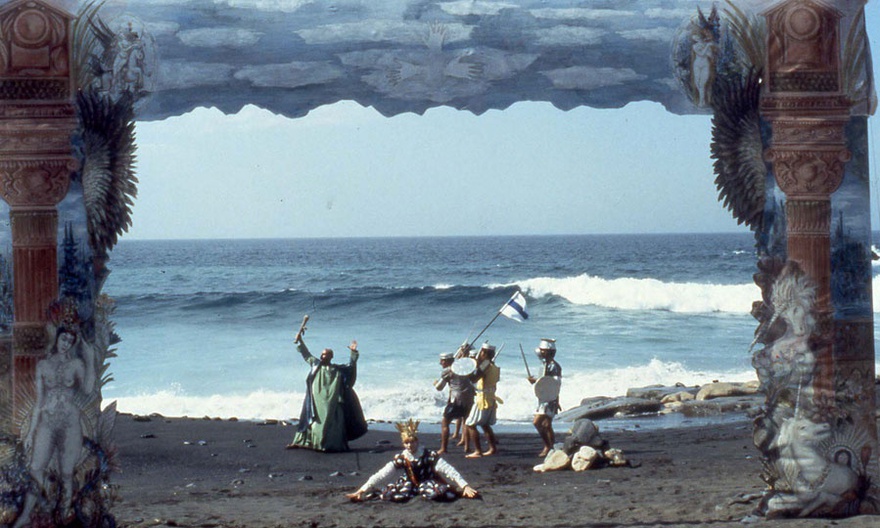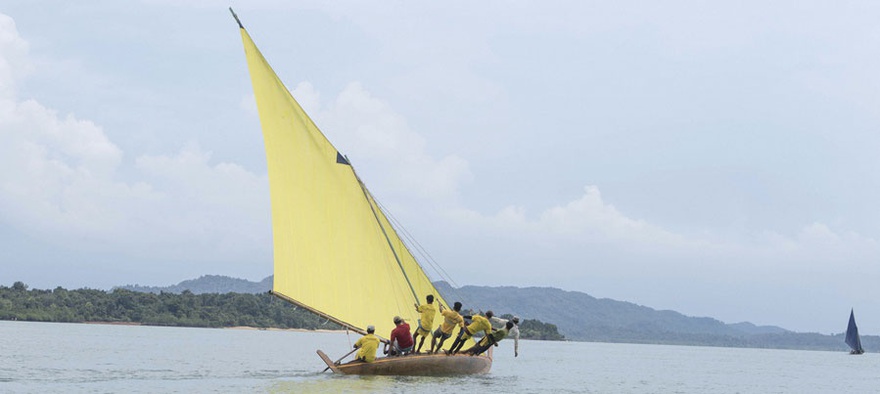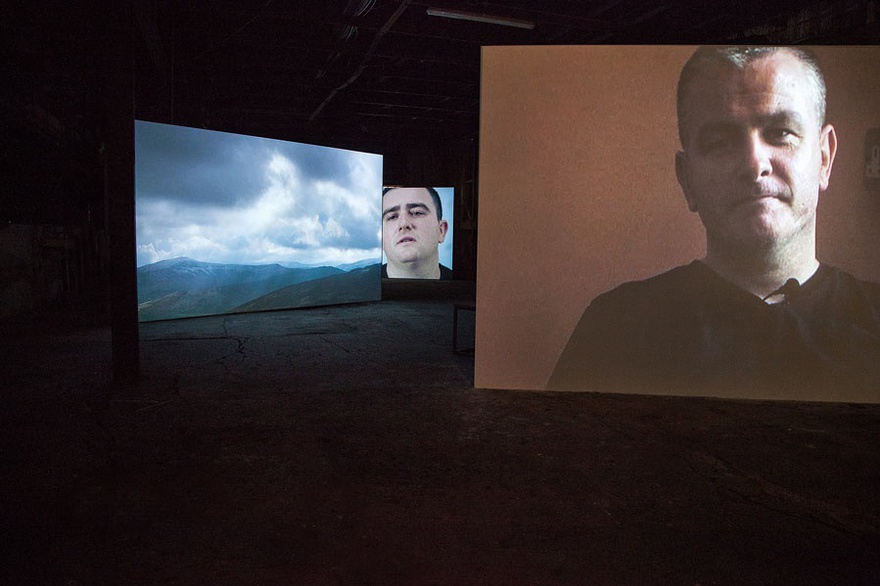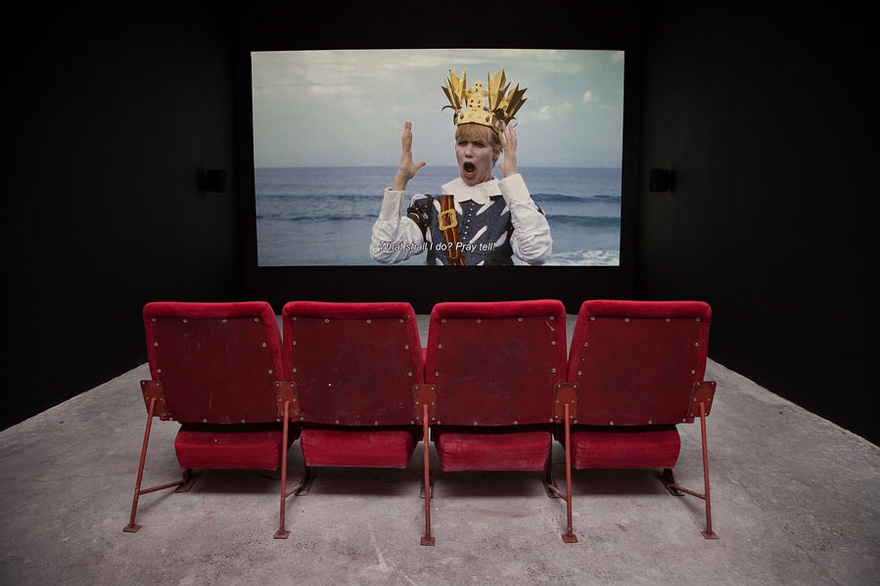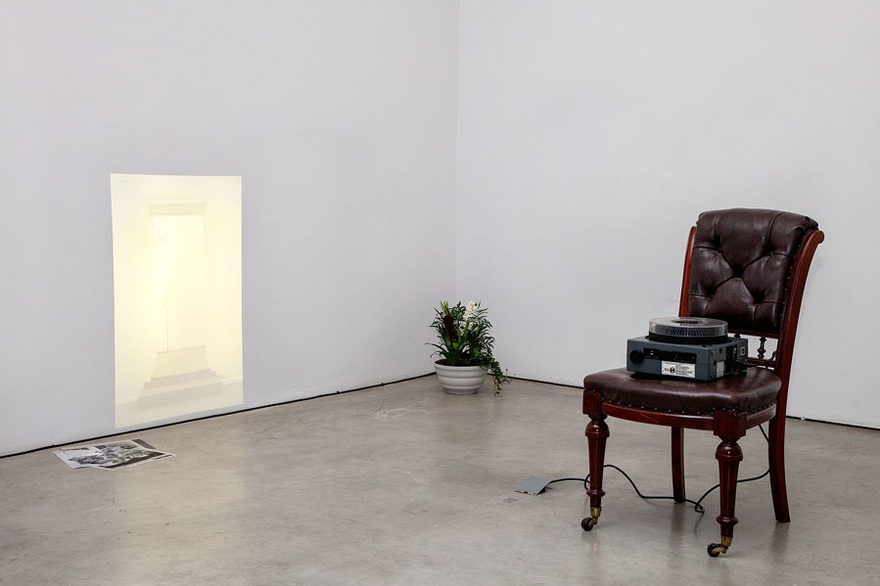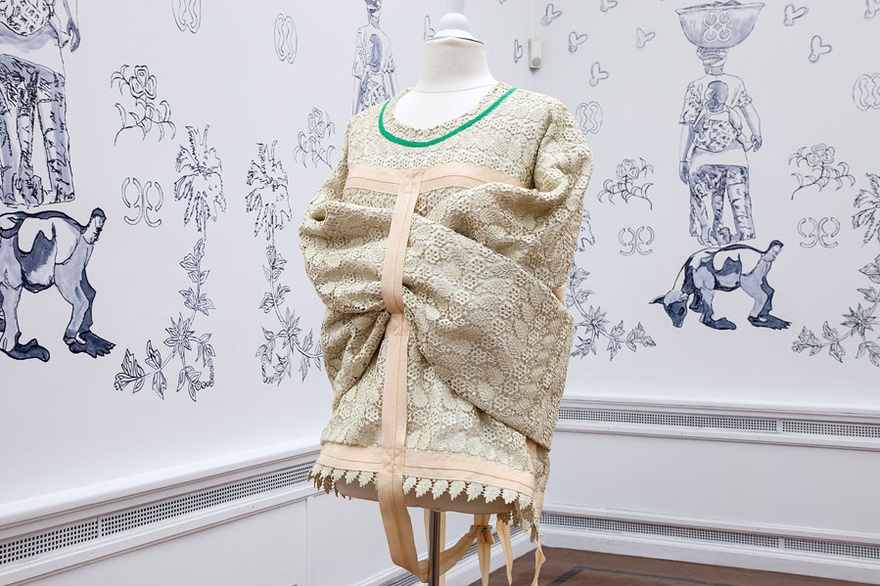Interviews
Still (the) Barbarians
Koyo Kouoh in conversation with Stephanie Bailey
'Still (the) Barbarians', the title of this year's EVA International biennial in Limerick, Ireland, is inspired by the 1916 Easter Rising, which commemorates its centenary this year, and a poem by Constantine P. Cavafy, in which the barbarians become a projection for inaction. The exhibition effectively reminds us of Ireland's postcolonial history, given that it was the 1916 events that set in motion the declaration of the Irish Free State and the establishment of the republican party, Sinn Fein. As the curatorial statement notes, curator Koyo Kouoh has taken this historical event as a starting point from which to 'examine the relationships between the various forms of mental, physical and institutional decolonization across the world in comparison to Ireland as the primary testing territory of Western colonization systems before their expansion to the global map'. The intention, as Kouoh states, is 'to draw a concentric artistic and political cartography, mapping the conflations and confines of the global postcolonial typology with Ireland as its central starting point.' In this interview, Kouoh, founder of RAW Material Company in Dakar and prolific curator, talks about the thematics of a biennial that engages with the complex identities that arise out of colonial histories.
Stephanie Bailey: You consider Ireland 'the first and foremost laboratory of the British colonial enterprise', and the site 'has always been a fixture in [your] thinking on the psychological and political effects a system designed to humiliate and alienate can have on peoples' souls'. Could you elaborate on the importance of claiming a position for Ireland as the first post-colony within the wider framework of the postcolonial world, which is so often associated with the Global South, rather than the Global North?
Koyo Kouoh: 800 years of occupation leaves lasting marks on the land, psyche, politics and economy, to name just a few areas. Europe has educated itself to believe that the colonial enterprise was a programme performed in far-flung places whereas history teaches us that Norway stopped being a playing ball in the hands of Sweden and Denmark in 1905, Ireland obviously liberated itself from British rule in 1916 and Greenland is still occupied by Denmark. All occupied territories that experience the struggles of liberation are in recovery, and in that share similar processes of regaining national confidence. It is in this experience that I see that Ireland has more in common with countries in Africa, Southeast Asia and Latin America despite its geographical location in Western Europe. It may be disturbing but it is nonetheless a valid position.
SB: How does the choice of artists and works you have made for this exhibition reflect your approach to – or understanding of – the question of postcoloniality in the twenty-first century from the starting point of Ireland?
KK: This year marks the centenary of the Easter Rising, a moment of great significance in the struggle for liberation from British colonial rule, and Ireland has heavily invested in commemorating this. The commemoration is somewhat detached from the trauma of the revolution, or uprising, that began the process of detangling from the colonizer. With Still (the) Barbarians I want to locate Ireland within the contemporary postcolonial discourse and unpack some of the consequences of decolonization still apparent today. Take, for example, one of the most palpable consequences of colonial domination: the erosion of language. For me, as an outsider looking at Ireland, I see such ambivalence about the Irish language: who speaks Irish, who doesn't speak Irish; who feels Irish should be the national language, or not. One could ask: is language a token symbol of a culture?
Another layer of postcolonialism that I am really interested in is forms of memory – visual memory, physical memory and inherited memory – how these play out day-to-day and how artists approach this idea. I strongly believe that the features of occupation and domination – especially by major colonizers such as Britain, France, Portugal and Spain – are more or less the same. This is why the participating artists are from a very broad spectrum of cultural backgrounds.
SB: Could you elaborate on the features of occupation and domination you identify among the historical colonizers of the last 500 years from the western world, and identify how you see these features being represented and subverted in the various works that make up this biennial?
KK: To go back to that idea of memory, inherited and collective memories are features of nation building; of creating a new collective story. Kapwani Kiwanga's installation A Memory Palace (2015) takes that notion of creating or manifesting memory by creating a 'memory palace' in the exhibition. A memory palace is an ancient Greek method of memory enhancement that uses visualization to enhance memory. The work references the now demolished old Reichskanzlei (Reich Chancellery), which was located in Berlin and set the stage for the 'scramble for Africa'. The images that Kapwani uses work together in an attempt to create new stories, prior to the collapse of that building in the second world war.
Charles Lim Yi Yong's video Stealing the Trapeze (2016) looks at how the trapeze was claimed by the British as their own invention, but in fact it is part of the history of catamarans, a type of boat seldom constructed in the temperate West before the nineteenth century, but in wide use as early as the fifth century AD in what is known today as South India. Tiffany Chung reappropriates and subverts the empirical enterprise of claiming and marking territory by creating maps that examine the geographical shifts in countries traumatized by war, human destruction, or natural disaster. Her map drawings layer different periods in the history of devastated topographies, reflecting the impossibility of accurately creating cartographic representations of place and the arbitrary nature of borders. Finally, rappers Journal Rappé's work takes the form of a news bulletin to present a 'rapped' news programme. The parody tells news stories which are closer to daily Senegalese life and has become extremely popular in Senegal and, from its beginning on social media, is now included in the schedule of an official broadcaster.
Works were selected through an open call as well through commissioning. Guiding lines in this process were the contemporary translation of the proposal as well the degree of subversion thereof. Through an open competition, members of the public were invited to create a citizens' anthem that is representative of contemporary Ireland, reflecting on themes such as equal opportunities, liberalism, freedom, welfare, security, and democracy. The winning anthem was played by two ice-cream vans on 24 April 2016, marking the exact centenary of the Easter Rising.
Nevertheless my curatorial approach is not one that attempts to illustrate my conceptual proposal, but rather seeks to present practices that deal with the subject matter in the most creative and subversive manner, such as the remarkable work by John Waid, 909,125 minutes later (2016), that aimed to reclaim the time that Ireland lost in its alignment to British time.
Many of the artists directly responded to the local context; for example, Godfried Donkor worked with a group in Limerick, the Limerick Lacemakers to produce his piece Rebel Madonna Lace (2016). The area's history of lace production as well as symbols from the Ashanti people in Ghana bridge that distance between the continents. While, Michael Joo's three-part installation This Beautiful Striped Wreckage (Which We Interrogate)... (2016) in the Sailor's Home, directly responds to the nineteenth century building with an ambiguous past. Limerick-based artists Deirdre Power and Softday (the art-science collaboration of artist Sean Taylor and computer scientist Mikael Fernström) developed a socially engaged project that explicitly contributes to the existing debate related to the legacy and contestations of the 1916 Easter Rising.
Irish artist Jonathan Cummins presents an inter-connected film installation that traces the impact of militant ideological conviction, both on the self and on the family, through a series of conversations with a group of IRA anti-Good Friday Agreement activists and their families. These significant and sensitive films have evolved from Cummins' work with political prisoners in Portlaoise Prison, the maximum-security prison in County Laois. The conversation begins in prison with When I Leave These Landings (2004–09), continues after the men's release with Go Home (2010–13), and extends to include the men's families in Out the Road (2012–15).
SB: The curatorial statement also talks about 'the convecting discourses on racism', which you position as 'a foundational and enduring system for exclusion and exploitation' to which Ireland was also heavily subjected to. I'm interested in how you have located discourses of racism within the Irish experience and connected them to a wider milieu of colonial occupation, exploitation and oppression that re-roots the postcolonial condition right back in the western world. Here, Larry Achiampong and David Blandy's collaborative two-part film, Finding Fanon (2015), seems to be a key work, in that it considers the legacy of Fanon in such a way that recalls Jean-Paul Sartre's foreword to The Wretched of The Earth, in which Sartre warned the west that the effects of colonization will inevitably reach the shores of Europe.
At the same time, Still (the) Barbarians turns the politics of blackness on its head, by consciously and thoroughly breaking down any chance of a black/white binary by grounding the shared post-colonial legacies of the world in Ireland. I wonder if you could expand on this?
KK: Up to the 1960s one could encounter signs in London's restaurants and shops saying 'no Irish, no Blacks'. Racism coupled with capitalistic greed was at the root of the colonial enterprise. It was an organized assault on people's dignity that left enduring marks of inferiority that transcend generations, and still affects present day human interaction.
Still (the) Barbarians invites us to look at the postcolonial condition on a comparative rather than a binary level. It is not only given from an Irish perspective but also from an African perspective, a Southeast Asian perspective, and a South American perspective. The whole selection of artists is an attempt to show that the local is in the global and that the global has an influence on the local, and how these contemporary issues are a matter of interdependency and similarities of processes of recovery from the colonial experience. It is a question of how to connect different national repercussions on both sides of the colonial line to the world that we live in today. Nowadays, even the most remote or isolated places are connected to the rest of the world because of the flurry and flood of information we have access to.
The term 'black' has been a signifier for disadvantage, second class and negativity in general forever, inasmuch that it is continuously appropriated by anyone in need of visualization of inequalities. However, my exhibition-making practice is one that is concerned with the multiple and diverse processes of the digestion of dispossession, alienation and subjugation, not to mention forms of exploitation that the colonial system applied profusely and that the neoliberal system is perpetuating today. It can therefore not be reduced to a colour in the same way that 'blackness' does not hold the monopoly of struggle. The complexities and entanglements of international relationships are a challenge that we have to face on an almost daily basis. There is no easy way out.
SB: There is of course an absurdity to the complexities and contradictions we have inherited from our colonial histories, something Ulrike Ottinger's incredible short film, The Conquest of the Happy Islands – A Colonial Opera (1983), touches on. It reminded me so much of William Kentridge's recent work, Notes Towards a Model Opera (2015), in which the colonial experience is likewise abstracted into a much more global production; one that is as much theatrical as it is dramatic, farcical and tragic. Does this comment resonate at all?
KK: Considering colonization objectively, while impossible, shows us the absurdity of it. I have previously cited Achille Mbembe's 2001 book, On the Postcolony, in which he challenges some of the key assumptions of postcolonial theory. Developing the notion of the banality of power in contemporary Africa, he reinterprets the meanings of death, utopia, and the divine libido as part of new perspectives on the constitution of power. He works with the complex registers of bodily subjectivity – violence, wonder, and most importantly laughter – to counter categories of oppression and resistance, autonomy and subjection.
SB: In this light, how does the curatorial respond to an insistence on building 'contemporary fictions and future utopias of togetherness' that you have stated as a key intention of this exhibition in particular?
KK: This edition of Ireland's biennial is an attempt to reach a visual and mental synthesis. The idea is that the troubled relationship between the colonizers and the colonized – each relationship is, of course, specific and unique to a certain place and time – is always overshadowed by overwhelming sadness, violence, and despair, and reveals the vicissitudes of the human condition
In the same way that the colonized cannot deny their past, Europe cannot exonerate itself from the conduct and consequences of imperialism through denial and silencing. The current refugee crisis is just the tip of an iceberg of intricate and entangled fraught relationships forged during that era of massive exploitation. Their impacts continue to define our present day. Still (the) Barbarians looks to the past, present and future of postcolonial features. It is my intention that the artworks presented at EVA enable the visitor to feel, to think, and to heal.
SB: Would you say this exhibition is a response to the increasingly essentializing manner to which culture is being used not only within the realm of local, national, and global politics, but within art, too?
KK: I can hardly believe that any exhibition has the power to offer responses to global politics, nor do I have the pretention to think that this particular exhibition might be any different. From my point of view, an exhibition is neither a newsroom nor a research lab. It is at best a conversation that can leave a lasting memory. I composed Still (the) Barbarians with an aim to tell a story that is under the radar. Using the postcolonial lens to look at Ireland and unpack the reality that the country may have more in common with countries in Africa, Southeast Asia and Latin America than acknowledged may be disturbing. but it is nonetheless an intriguing viewpoint.
For instance, Michael Joo's work This beautiful striped wreckage (which we interrogate)… includes, among other pieces, a video shot in the British Museum – the world's greatest vault of colonial thefts – of the sculpture of an emaciated Buddha from third century Pakistan, which depicts the human form of the Buddha Shakyamuni in his attempt to reach enlightenment. In installing this particular work in the Sailor's Home, Joo uses the building as a body of transmission for a conversation between Britain and Ireland via Pakistan. This offers an opportunity for discussion and reflection.
SB: How did your practice as a curator and as the director of RAW Material Company in Dakar influence your approach to curating EVA International?
KK: I started RAW Material Company in 2008 because, as an exhibition maker and researcher, I realized that I didn't have access to a space in which I could discuss art as a thinking system in its own right, without the surplus theories of other disciplines. Context very much defines everything that we do and RAW Material Company is a space that responds specifically to its Dakar context. I am interested in the critical aspects of artistic practice and in how art intervenes in society, and in politics specifically, providing another language for discourse. This, I hope is apparent in Still (the) Barbarians.
SB: To your mind, and based on your experience as a curator working across the world and in a variety of forms and contexts, from the 1:54 Contemporary African Art Fair to Documenta, how might art contribute to the discourses today in a world that feels increasingly polarized as a direct result of colonial legacies?
KK: From its humble beginning as craft, sculpture and painting, artistic practice has been concerned with representation. Regardless of the multiple developments of the practice as well as the many liberative movements such as Dada, surrealism, conceptual art, relational aesthetics, institutional critique and socially engaged practices, representation remains a steady form in artistic production globally. Seen as such, the contribution that art can make to challenging political realities of our times can only be representational, a sort of additional layer of understanding for awareness. Politics are a force that at its best strive for change and transformation that art alone hardly has the power to effect nor is it its role for the matter.
SB: In terms of locating your edition of the EVA International in the history of the exhibition itself, did you draw from previous editions at all, in terms of creating continuity to discussions that have developed throughout the biennial's history?
KK: EVA began locally, which really makes it very special. It is an event that was initiated by artists for artists. Very few people know that EVA has existed for 39 years. If you look at the line-up of curators and artists that have shown there, it's quite amazing. It is one of the only biennials that doesn't put curators in competition with other curators. In many ways – but not consciously – this edition of EVA International, the 37th, picks up various threads of the conversation that Bassam El Baroni's AGITATIONISM began in 2014. Bassam's edition of EVA looked at how over the past few years we have witnessed protests unfolding into serious unrest across many parts of the world.
The unrest we are witnessing these days in the Mediterranean basin is to a large extent the result of fraught relationships forged during the colonial era and perpetuated after the liberation movements. The gross inequalities and systems of exclusion that emerged out of these relationships are at the basis of the rise of fundamentalism and extremism that is plaguing our current times. This confirms my thesis that the past is always present and the future never really arrives.
Koyo Kouoh is an exhibition maker and the founding artistic director of RAW Material Company, a centre for art, knowledge and society in Dakar. She is the curator of 1:54, Contemporary African Art Fair in London and New York. Kouoh has served as curatorial advisor for Documenta 12 (2007) and 13 (2012), and co-curated Les Rencontres de la Photographie Africaine in Bamako in 2001 and 2003. Her most recent projects include: Streamlines: Oceans, Global Trade and Migration, Deichtorhallen, Hamburg (2015–16); Body Talk: Feminism, Sexuality and the Body in the work of six African women artists, WIELS, Lunds Konsthall, and 49N6E FRAC Lorraine (2015–16); Precarious Imaging: Visibility surrounding African Queerness, RAW Material Company (2014); Word!Word?Word! Issa Samb and the undecipherable form, RAW Material Company/OCA/Sternberg Press (2013), the first monograph dedicated to the work of seminal Senegalese artist Issa Samb; Condition Report on Building Art Institutions in Africa, a collection of essays resulting from the eponymous symposium held in Dakar in January 2012; and Chronicle of a Revolt: Photographs of a Season of Protest, RAW Material Company and Haus der Kulturen der Welt (2012).
Besides a sustained theoretical, exhibition, and residency programme at RAW Material Company, she maintains a critical curatorial, advisory and judging activity internationally. In collaboration with Rasha Salti, Kouoh is working on 'Saving Bruce Lee: African and Arab Cinema in the Era of Soviet Cultural Diplomacy', a research, exhibition and publication project to be held in late 2017 across different institutions. She lives and works in Dakar and occasionally in Basel.

